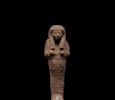Ushabti for Amenemopet
A cedar wood mummiform ushabti, with a carved hieroglyphic inscription identifying the owner as Amenemopet. The figure wears a striated wig and carries the typical adze and hoe against its chest, with a seed bag suspended in the back from both shoulders. The front features seven lines of sunk relief inscription with traces of light blue pigment. Unfortunately, many wood sculptures found by Bedouin in the 18th and 19th centuries were used as firewood; however, the present piece has survived the ordeal in relatively fine condition.
Ushabtis were intended to spare their owners from manual corvée labour in the afterlife, as a stand-in for both the deceased and their servants. In the 18th Dynasty, these statues were referred to as ‘shabti’, but by the Late Period the word ‘ushabti’ came into use. ‘Ushabti’ may derive from the verb ‘wesheb’, meaning to answer, in reference to Chapter Six of the Book of the Dead (known as the Ushabti Chapter), which describes how ushabti should answer the call to work in lieu of their owners. This passage is frequently inscribed on the front of ushabti.
Condition
Intact, some slight fire damage at the back, general wear.
Maurice Nahman Collection, Hotel Drouot, Paris, 4-5 June 1953, Lot 49.
Antiquities, Christie’s, 25th April 2007, London, Lot 89.
Egyptian Antiquities, Charles Ede Ltd, 2008, Lot 36.
Previously with Maurice Nahman (1868-1948), from at least 1948.
Sold at: Maurice Nahman Collection, Hotel Drouot, Paris, 4-5 June 1953, Lot 49.
Private Collection, France (accompanied by French cultural passport 089393).
Sold at: Antiquities, Christie’s, 25th April 2007, London, Lot 89.
With Charles Ede Ltd, acquired from the above sale.
Private Collection, USA, acquired from the above 19th January 2011.
ALR: S00229528, with IADAA Certificate, this item has been checked against the Interpol database.
Maurice Nahman (1868-1948) was born in Cairo to banker Robert N Bey and Sarina Rossano. He began working as a cashier at Credit Foncier Égyptien in 1884, and was promoted to Head Cashier in 1908. In 1924 Nahman retired in order to focus on his gallery full-time. His interest in antiquities began at a young age, and he began dealing in art in 1890. In 1913 he purchased 27 Madebegh Street (now Sherif Street), a vast palazzo of Arab style, which held a large gallery where he displayed his antiquities – the building later known as ‘Casa Nahman’. Though mostly recognised as a dealer of ancient Egyptian antiquities, Nahman also dealt in high quality Coptic and Islamic artefacts.
Through his half a century of daily experience with Egyptian antiquities, Nahman became an expert in identifying forgeries, and his opinion was sought out by many specialists. As advertised on his calling card, Nahman supplied objects to many major museums, including the Egyptian Museum in Cairo, the British Museum, the Musée du Louvre, the Museum of Fine Arts in New York, and the Museum of Berlin. His gallery guestbook includes the likes of Chester Beatty, Hagop Kevorkian, Bernard von Bothmer, Maurice de Rothschild, and John Rockefeller.
A premature obituary for Nahman was written by Belgian Egyptologist Jean Capart in 1947, as a result of an incorrect rumour that Nahman had died (Chronique d’Egypte, 1947, 22:43). Capart praised Nahman as ‘le plus grand marchand d’antiquités égyptiennes du monde’. This obituary was republished after Nahman’s death, in the same issue of Chronique d’Egypte as Capart’s own obituary. After Nahman’s death in 1948, his son Robert continued the antiquities business until he passed in 1954. The sale at Hotel Drouot in June 1954 at which this ushabti was sold was one of two large posthumous sales of the Nahman collection.










 Enquire
Enquire




